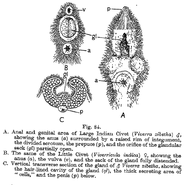Scent gland
| Scent gland | |
|---|---|
 | |
 The arrow is pointing to the metatarsal gland of a Sika deer | |
| Details | |
| Identifiers | |
| Latin | glandula odorifera |
| MeSH | D012543 |
| Anatomical terminology | |
Scent gland are
In even-toed ungulates
The
Like many other species of Artiodactyla, deer have seven major external scent glands distributed throughout their bodies.[3] Deer rely heavily on these scent glands to communicate with other members of their species, and possibly even with members of other species. For example, male white-tailed deer (Odocoileus virginianus) are often seen working over a scrape. First, the animal scrapes at the dirt with its hooves, depositing the scent from his interdigital gland on the ground. After that, he may bite the tip off an overhanging branch, depositing secretions from his salivary glands onto the branch. He may then rub his face on the overhanging branch, depositing secretions from the sudoriferous and preorbital glands on it.[5]
The interdigital glands of male and female black-tailed deer contain three volatile ketones, 2-tridecanone, (E)-3-tridecen-2-one and (E)-4-tridecen-2-one. (E)-3-tridecen-2-one was shown to have antibiotic activity against some skin pathogens.[6][7] These compounds are absent from white-tailed deer interdigital glands, which contain a number of 2-Methylcarboxylic acids. [8]
The tarsal gland appears to operate by a different mechanism than the other external scent glands. A behavior called
In carnivorans
In other animals
- Apocrine sweat glands, such as in the armpits of humans
- Sebaceous glands, such as the cranial surface glands of the red-bellied lemur
- Flank glands, such as in voles or shrews[15]
- Various glands producing pheromone signals found in nonavian reptiles, including Crocodylians[16]
- Castor sacs, found in beavers
- Perineal glands, found in
- Preputial glands, found in many species including mice, pigs, and wolves[11]
- Supracaudal glands, found in canids[20]
See also
- Deer musk
- Red fox#Scent glands
- White-tailed deer#Marking
- Ozadenes, defensive glands of some arthropods that emit noxious compounds
References
- ISBN 978-0471102533.
- ^ ISSN 0340-1022.
- ^ a b Nickens, TE (2009-11-05). "Understanding seven deer glands". Field & Stream Online. New York: Field & Stream. Retrieved 2012-05-27.
- ISBN 9783540213086.
- ^ "Understanding deer glands". Huntley, Illinois: Hunting Network, LLC. 2012. Retrieved 2012-05-21.
- .
- .
- .
- ISBN 978-0-520-08085-0.
Scent glands.
- JSTOR 3503919. Retrieved 19 May 2010.
- ^ ISBN 978-0-226-51698-1.
- ISBN 978-0-7216-1332-1.
- ^ Kenyon, KW (1969). The Sea Otter in the Eastern Pacific Ocean. Washington, D.C.: U.S. Bureau of Sport Fisheries and Wildlife.
- ^
Ford, LS; Hoffman, RS (1988). "Potos flavus". Mammalian Species (321): 1–9. JSTOR 3504086.
- JSTOR 1379814.
- PMID 18663393– via Researchgate.
- ISBN 978-0-8014-8493-3.
- ^ Beauchamp, Gary K. "The perineal scent gland and social dominance in the male guinea pig." Physiology & behavior 13.5 (1974): 669-673.
- ^ Roze, U., et al. "Microanatomy and bacterial flora of the perineal glands of the North American porcupine." Canadian Journal of Zoology 88.1 (2009): 59-68.
- ^ Fox, Michael W., and James A. Cohen. "Canid communication." How animals communicate (1977): 728-748.
